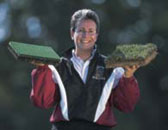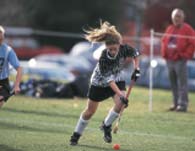Splendor in the (Synthetic) Grass
Suzanne Coffey, Bates director of athletics, weighted the merits of AstroTurf vs. grass, and the decision was a no brainer.
By H. Jay Burns
AstroTurf was supposed to be the good guy, a triumph of American know-how for all humankind. Sure, grass would always be a poetic triumph for Walt Whitman but AstroTurf – so practical! – would surely take its place in the American experience alongside Saran Wrap, velcro, and the oversized titanium driver with a head the size of a grapefruit.

In the optimistic 1950s, the Ford Foundation, looking for social ills to cure, urged the development of a synthetic grass to give out-of-shape city kids more places to play. Yet the laudable heritage of what would become AstroTurf never entered the public’s mind. Instead, mainstream America saw AstroTurf’s first wide-scale use in the 1960s in the Houston Astrodome, installed only after a natural-grass field wilted and died. Grass is dead; long live AstroTurf. Of course, the Brady Bunch had an AstroTurf backyard, and then despised cookie-cutter sports stadiums rolled out AstroTurf in the 1970s to complete the aesthetically off-putting package.
Yet, here comes AstroTurf (also known as synthetic athletic turf) to Bates in the form of a new $1-million multipurpose field. Installed over the summer behind John Bertram Hall, the field now offers day use and lighted use at night for varsity, club, and intramural programs. What at first seems ironic – AstroTurf at a New England college that splashes its campus greenery in every publication – reveals itself as nothing short of a perfect fit with the Bates sports culture.
In fact, Bates and other schools of the New England Small College Athletic Conference are turning to AstroTurf for practical reasons, not poetic ones.
“Bates needed new fields, and we think we’re getting the equivalent use of three grass fields out of one turf field,” said Suzanne Coffey, director of athletics.
While a range of outdoor sports can practice and play on the synthetic turf field, field hockey and men’s and women’s lacrosse will be the primary users.
Simply put, “field hockey can be played at a much higher quality on a synthetic surface,” Bates head coach Wynn Hohlt said.
“As our field hockey program gets better and achieves national recognition, a turf field becomes more necessary,” said Coffey, a former field hockey coach herself. “The better teams want to play on the fastest surface possible, because that’s where superior skills emerge. Players like Julia Price ’03 and Johie Farrar ’03 are wonderful players on grass. On turf, they’ll be fantastic.”
With any new Bates offing, themes of fairness and egalitarianism are the backbeat to any discussion of excellence.
“Even if you set aside field hockey and lacrosse, Bates intramural and club sports will be able to use the fields until 10 at night, or later,” said Coffey. “It will have five-yard marks for football, too, and skiing could use it for dryland training. We hope to offer it for near-constant use.”
The field can be used until snow flies (indeed, the campus was snowless last fall well into December). And the moment the snow disappears in early spring, perhaps sooner with the help of a campus snowplow, the field will be in use. Probably not since 1925, when Bates built the Gray Athletic Building, the sine qua non of the legendary Bates indoor track program, has a College sports facility so thoroughly thumbed its nose at the Maine weather. The Bates Alumnus called the Gray Cage “the latest development in physical training equipment, particularly in institutions located in northern climates.”
Fairness and access were selling points for the Gray Cage, too. “While…athletic teams will benefit by the opportunities offered by such a building….its primary object, developing sound minds and sound bodies through play and intramural sports, shall never be obscured,” wrote The Bates Alumnus. And that meant women as well as men. “The women of Bates College shall always have equal right and opportunity with the men to the use and enjoyment of this building.”
Bates is among the first schools in the high-powered NESCAC to install a synthetic turf field. Middlebury installed a turf field last year. Bowdoin and Trinity are joining Bates’ lead this year, and Trinity joins the turf club next year, Coffey said. “We’re all installing what’s known as AstroTurf 12,” the plushest and least abrasive surface offered.
The field is part of a $4-million package of sports facilities including a new softball field and new track and field. A separate sports project, the James Wallach ’64 Tennis Center, was completed over the summer and will be dedicated Oct. 7. The courts are located adjacent to Underhill Arena.
Given the College’s history of wise financial planning, the investment in a turf field had an economic component that would even please the late legendary treasurer Norm Ross ’22. Not only will Bates get three fields’ use from one turf surface, but Coffey estimates the turf field will save Bates half a million dollars in maintenance costs over 10 years. And let it rain, said Coffey, because the porous surface and base of a turf field can withstand up to five inches of rain in an hour and not turn into a sea of mud after a slew of fall weekend games. “With a grass field, you couldn’t expect it to be usable on a Saturday after a rainstorm, given all the hours of use it sees.”
And the aesthetics of a turf field on a beautiful, otherwise grassy New England campus hasn’t raised eyebrows on campus. “I think it’s great,” said Dick Williamson, professor of French and Bobcat sports fan. “Hey, we used to shovel ponds to play hockey. Then came covered, heated hockey rinks. And that wasn’t a bad idea.”
Professional football and, especially, baseball teams have moved away from AstroTurf in the 1990s. And high-profile injuries, like the torn Achilles’ tendon suffered by New York Jets quarterback Vinnie Testaverde last year, are often blamed, justly or unjustly, on synthetic turf.
“There’s never been any study that shows a greater amount of injuries on turf than grass,” said Allen Waterman, an AstroTurf sales representative. Yet he acknowledges the “negative perception” of turf, reinforced by injuries like Testaverde’s: “If there was no AstroTurf at the professional football level, it would benefit our company,” he said.
(The makers of AstroTurf, meanwhile, suggest that twisting injuries to knees and ankles might have to do with the shoes players wear, which they say offer too much traction. “We tell [NFL players] what shoes they should wear, but they don’t listen and use a shoe that has too much grip,” said Lee Defreitas, East Coast sales manager for AstroTurf. “I’ll suggest to [Bates football coach] Mark Harriman that his players just use a standard tennis shoe if they practice on the turf field.”)
But particularly at the high school and collegiate level, in sports like field hockey and lacrosse, a turf field is better, safer, and much more economical than a grass field, Coffey said.
“An NFL team can afford to spend $1 million a year on grass to make it perfect,” Coffey said. “Division III fields are not NFL quality. Sometimes fields are too hard, too soft, or uneven. And that adds to chance for injuries at our level.”
Coffey compared injury-rate data from the NCAA for grass and turf fields. She looked at 1998-99 Division III men’s soccer data, “typical of a high-impact sport that might be played on our field.” She found that the injury rate on grass surfaces was 4.56 injuries for every 1,000 athlete exposures. But the rate for turf surfaces was just .30 injuries per 1,000 exposures.

Pro football and baseball fans hear and read player and media grumbles about synthetic turf. Yet over the last three decades, synthetic turf has become the preferred surface for sports like field hockey. The turf revolution in field hockey began in 1975, with the installation of an AstroTurf surface at McGill University’s Molson Stadium. That year, the stadium hosted the “8-Nations” tournament, the first international field hockey competition held on a synthetic turf field. The fast and true surface got rave reviews. The International Hockey Federation now requires international competition be played on synthetic turf.
Bates field hockey player Johie Farrar ’03 of West Paris, Maine, said AstroTurf makes her sport better for players and spectators. “It’s not a power game” on synthetic turf, said the second-team regional All-American. On an imperfect grass field, players pass less and shoot from long range more often, hoping for lucky bounces. On turf, “the drive isn’t as important. The game has more skill. It’s faster and quicker. It’s fun and I like it.”